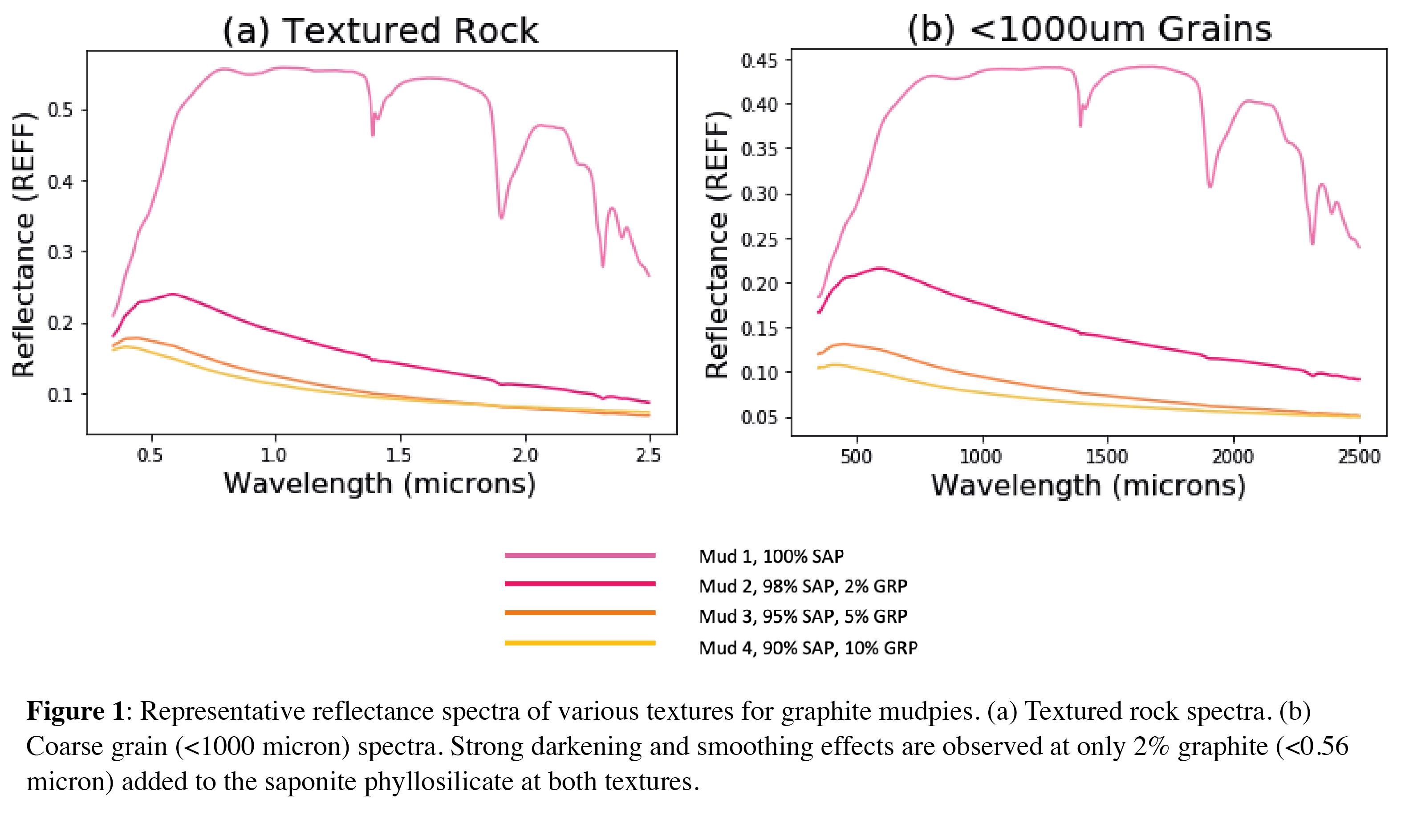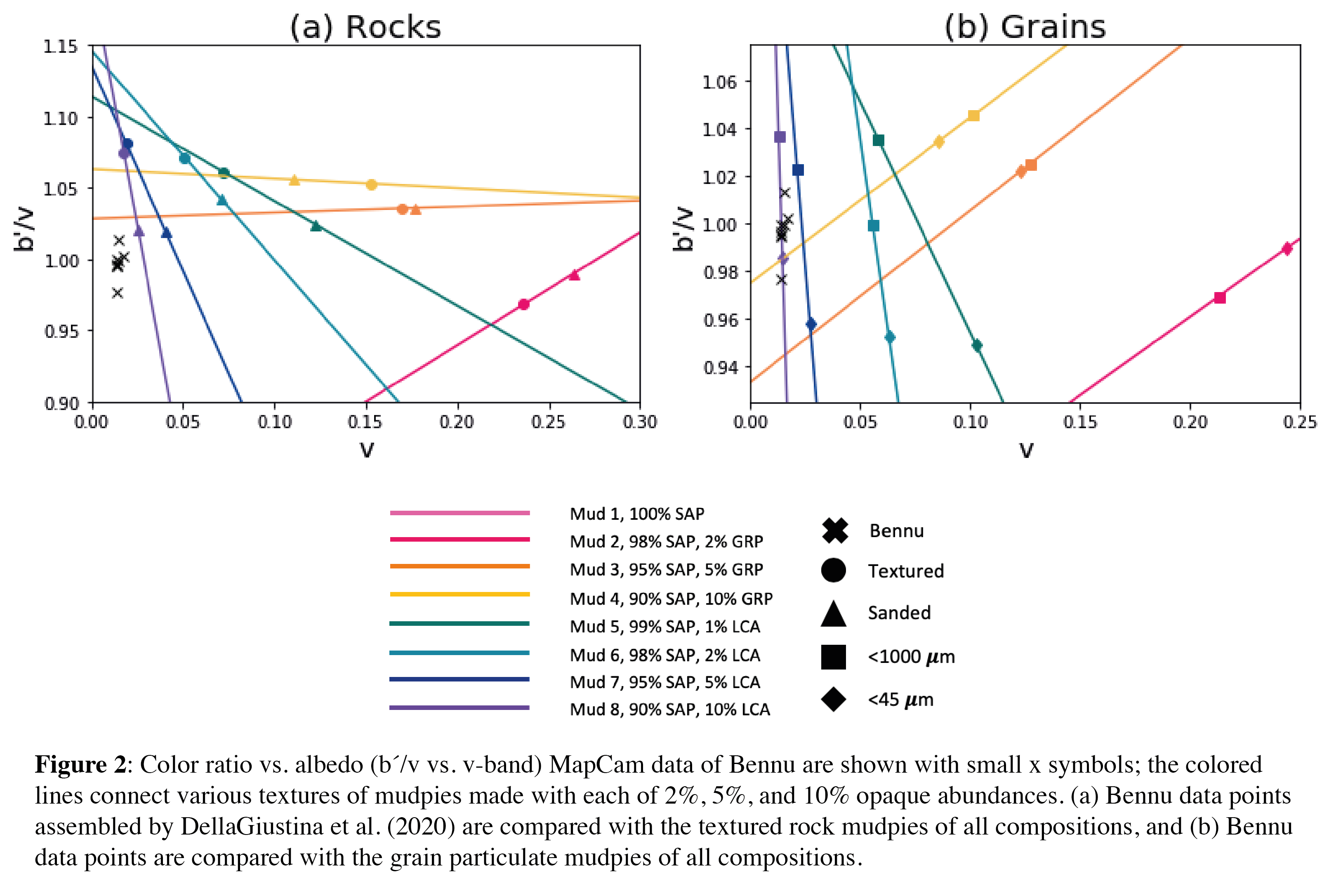Color Effects of Textural Variations on Bennu: Comparison of Analog Laboratory Mixtures with OSIRIS-REx Data
- 1Department of Physics and Astronomy, Ithaca College, Ithaca, NY, USA (asen@ithaca.edu)
- 2Centre for Terrestrial and Planetary Exploration, University of Winnipeg, 515 Portage Avenue, Winnipeg, Manitoba, Canada R3B 2E9
- 3Planetary Science Institute, USA
- 4Lunar and Planetary Laboratory, University of Arizona, Tucson, AZ, USA
OSIRIS-REx is a sample return mission to near-Earth Asteroid (101955) Bennu (Lauretta et al. 2017). The asteroid is spectrally classified as a B-type (Clark et al. 2011), and phyllosilicates similar to those found in carbonaceous chondrites have been detected on its surface (Hamilton et al. 2019). Bennu has a relatively flat (and blue) reflectance spectrum in the 0.4 to 3.7 micron spectral range and has a low albedo of ~4.5% (Golish et al. 2020).
Bennu has a rough and rocky surface. Imaging data from the OSIRIS-REx Camera Suite (OCAMS; Rizk et al. 2018) reveals that boulders in the size range from 1 to 10 meters dominate the surface (Lauretta et al. 2019; DellaGiustina and Emery et al. 2019). Observed boulder textures range from smooth to hummocky and breccia-like (Walsh et al. 2019; DellaGiustina and Emery et al. 2019). The smoother rocks appear to be smaller, brighter, and more angular, while the rougher rocks appear to be larger, darker, and highly textured. Because spectral variations on Bennu are subtle and associated with albedo (Clark et al. 2019), the question arises: Could the observed color variations be due to texture variations alone, or are space-weathering variations required to explain the observations? To isolate the spectral effects of texture on the spectral properties of Bennu, we first simulate Bennu’s spectrum using a two-component mixture, then we check to see whether texture changes in this analog can account for the observed color and albedo trends.
Simulated Bennu Spectral Analog: We synthesized physical mixtures of saponite (SAP105 with ~25 wt.% dolomite) with two forms of carbon: <0.56-micron particles of graphite (GRP102) and <0.021-micron particles of carbon lampblack (LCA101) (Figure 1). These mixtures have the consistency of fine silt and clay mud before they are dried and baked in an oven at ~200˚ Celsius, hence we call them “mudpies”. The spectrum of each mudpie was measured at four textures — textured rock (broken surface), sanded slab, coarse grain, and fine grain — using an ASDI LabSpec 4 Hi-Res in the wavelength range of 0.35–2.5 microns (Figure 1). We also modelled the spectra of intimate mixtures of serpentine with magnetite at the same four textures.
Bennu Spectral Data: We compare the measured and modelled mudpie spectra with Bennu’s reflectance spectra acquired by the OSIRIS-REx Visible and InfraRed Spectrometer (OVIRS, from 0.4 to 2.5 microns; Reuter et al., 2018), and with multispectral image data from the MapCam instrument (at 473, 550, 698, and 847 nm). We selected OVIRS spectra representing the full range of spectral properties of Bennu from the 12:30pm (local solar time) Equatorial Station 3 of the Detailed Survey campaign (Lauretta et al., 2017), at a ground sample distance of ~20 m per spectrum. We selected MapCam 4-point spectra similarly representing a full range of color properties of Bennu from the early afternoon Baseball Diamond Flyby 2 of the Detailed Survey campaign, at ~30 cm per pixel. With these datasets, we can constrain the best possible mudpie analogs for the surface texture and opaque abundance on Bennu. We find that the best analog mudpie for Bennu contains 10% carbon lampblack and 90% saponite.
In Figure 2, we show that the color variations observed on Bennu at 470 and 550 nm can be explained better with our best-analog mudpie ground to grain sizes between 45 and 1000 microns than with mudpies measured at two different surface textures (sanded slab and textured rock). Based on our color trend comparisons with the successful analogs, we conclude that mudpie simulated textures can fully reproduce the range of color trends observed on Bennu, and because texture effects have high-amplitude spectral effects, it is not necessary to invoke space weathering to explain the different color and albedo trends across Bennu’s surface.
However, according to DellaGiustina et al. (in revision), the geologic context of color trends on Bennu implies that space weathering effects may be required to explain the spectral bluing of craters over time. Hence, spectral variations on Bennu could be a combination of texture effects and opaque abundance variations caused by space weathering.
References
Clark, B. E., et al. Asteroid (101955) 1999 RQ36: spectroscopy from 0.4 to 2.4μm and meteorite analogs. Icarus 216, 462-475 (2011).
Clark, B. E., et al. Are the brighter rocks on Bennu products of recent mechanical weathering and therefore less space weathering? EPSC-DPS 2019, Geneva, Switzerland.
DellaGiustina, D. N., Emery, J.P., et al. Properties of rubble-pile asteroid (101955) Bennu from OSIRIS-REx imaging and thermal analysis. Nature Astronomy 3, 341-351https://doi.org/10.1038/s41550-019-0731-1 (2019).
DellaGiustina, D. N., et al. Diverse Color and Reflectance of Asteroid (101955) Bennu. Submitted to Science (in revision).
Golish, D.R., et al., Disk-resolved photometric modeling and properties of asteroid (101955) Bennu. Icarus https://doi.org/10.1016/j.icarus.2020.113724 (2020).
Hamilton, V. E., et al. Evidence for widespread hydrated minerals on asteroid (101955) Bennu. Nature Astronomy https://doi.org/10.1038/s41550-019-0722-2 (2019).
Lauretta, D. S., et al. OSIRIS-REx: sample return from asteroid (101955) Bennu. Space Science Review 212, 925-984 (2017).
Lauretta, D. S., et al. The unexpected surface of asteroid (101955) Bennu. Nature https://doi.org/10.1038/s41586-019-1033-6 (2019).
Reuter, D.C., et al. The OSIRIS-REx Visible and InfraRed Spectrometer (OVIRS): Spectral Maps of the Asteroid Bennu. Space Science Reviews, 214, 54 (2018).
Rizk, B., et al. OCAMS: the OSIRIS-REx Camera Suite. Space Science Review 214, 26 (2018).
Walsh, K. J., et al. Craters, boulders and regolith of (101955) Bennu indicative of an old and dynamic surface. Nature Geoscience https://doi.org/10.1038/s41561-019-0326-6 (2019)


How to cite: Sen, A., Clark, B. E., Cloutis, E. A., Hendrix, A. R., DellaGiustina, D. N., Applin, D. M., Connell, S., Parkinson, A., and Ferrone, S.: Color Effects of Textural Variations on Bennu: Comparison of Analog Laboratory Mixtures with OSIRIS-REx Data, Europlanet Science Congress 2020, online, 21 Sep–9 Oct 2020, EPSC2020-137, https://doi.org/10.5194/epsc2020-137, 2020.

